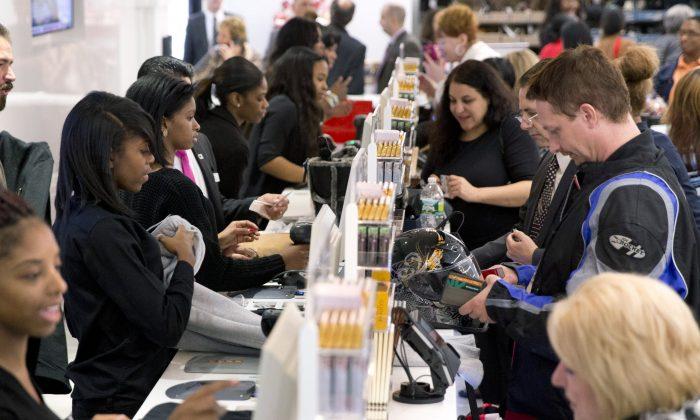WASHINGTON—The Federal Reserve is edging closer to raising interest rates from record lows given a strengthening U.S. economy. But it will be “patient” in deciding when to do so.
That was the message sent Wednesday as the Fed ended a meeting amid heightened expectation about a forthcoming rate increase. At a news conference afterward, Chair Janet Yellen said she foresaw no rate hike in the first quarter of 2015.
The Fed said in a statement that a “patient” approach to raising rates is consistent with its previous guidance that it would keep its key rate near zero for a “considerable time.”
Yellen said the strength of U.S. economic data and the level of inflation, not a calendar date, will dictate when it raises rates. At a time of global economic turmoil and collapsing oil prices, she stressed that the Fed was making no policy changes.
“The Fed is sending the message that the broader U.S. economy is on the path toward healing,” said Steven Ricchiuto, chief economist at Mizuho Securities. “They don’t know how fast it will heal, but it’s on the mend.”
The Fed chair said she’s prepared to let the U.S. unemployment rate fall from its current 5.8 percent to exceptionally low levels because doing so could help cause inflation to rise closer to the Fed’s 2 percent target.
Uncertainty about when the economy will fully heal from the ravages of the Great Recession, which officially ended 5½ years ago, is why the Fed’s policy statements remain vague, Ricchiuto added.
“There was no signal that rates are on the cusp of liftoff,” noted Joseph LaVorgna, chief U.S. economist at Deutsche Bank.
Stock investors cheered the Fed’s message. The Dow Jones industrial average, which had been up about 160 points before the Fed issued its statement, roared higher to close up 280 points. The stock market tends to applaud low rates because they make it easier for individuals and businesses to borrow and spend, and they cause many investors to shift money into stocks in search of higher returns.
Most economists think the Fed’s first rate increase will occur in June as long as its inflation outlook doesn’t remain persistently below its target rate of 2 percent. In an updated economic forecast Wednesday, the Fed lowered its inflation forecast for next year to between 1 percent and 1.6 percent.
Energy prices have plunged since the Fed last met in October, with oil reaching a five-year low. That price drop is reducing inflation further below the Fed’s 2 percent target, which could heighten the pressure to delay a rate hike until inflation rebounds. On Wednesday, the government said consumer prices rose just 1.3 percent in November compared with 12 months ago.
But Yellen noted that oil price spikes in the past had only temporarily raised inflation and suggested that a corresponding drop will likely also have only a “transitory” effect on inflation.
She was more optimistic about the benefits of lower oil prices for the U.S. economy.
“The decline we have seen ... is likely to be on net a positive,” Yellen said. “It’s something that’s certainly good for families, for households. It’s putting more money in their pockets... It’s like a tax cut that boosts their spending power.”
The Fed’s statement was approved on a 7-3 vote. The three dissents reflected the sharp divisions inside the Fed as it transitions from an extended period of ultra-low rates to a period in which it will start to raise rates. The Fed has not raised rates in more than eight years.
The dissents included Presidents Richard Fisher of the Dallas Fed and Charles Plosser of the Philadelphia Fed, who have long stressed the need for the Fed to prevent high inflation over the need to maximize employment.
But Narayana Kocherlakota, president of the Fed’s Minneapolis regional bank, also dissented for a different reason. He thinks the Fed needs to do more to boost inflation to its 2 percent target level.
The Fed’s decision to say both that it will be “patient” about a rate hike and that this is consistent with rates staying ultra-low for a “considerable time” was a surprise. Most economists had expected its statement to drop “considerable time” in favor of saying only that the Fed would be “patient” in assessing the economy’s ability to withstand higher rates.
In her news conference, Yellen said Fed officials felt it was unlikely they would vote to begin raising rates “for at least the next couple of meetings.” That would rule out a rate-hike announcement before April at the earliest.
Since the Fed’s last meeting, the job market and other sectors of the economy have strengthened. Employers added 321,000 jobs in November, sustaining the healthiest year for job growth since 1999. The current 5.8 percent unemployment rate is close to the 5.2 percent to 5.5 percent range that the central bank considers maximum employment.
The Fed’s key short-term rate has been at a record low near zero since December 2008. When the Fed does begin raising rates, the expectation is that it will do so gradually and leave consumer and corporate loan rates at historically low levels for a while.
In October, the Fed ended its bond buying program, which had been intended to keep down long-term borrowing rates. The bond purchases boosted the Fed’s investment holdings to close to $4.5 trillion — more than four times its level when the financial crisis hit in the fall of 2008.
From The Associated Press. AP Economics Writers Josh Boak and Christopher S. Rugaber contributed to this report.




